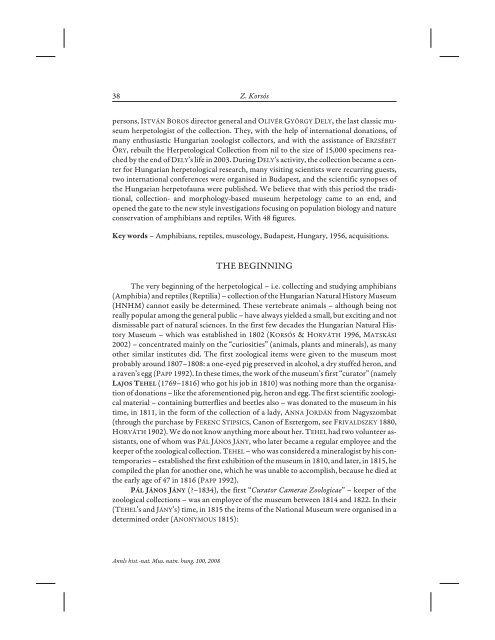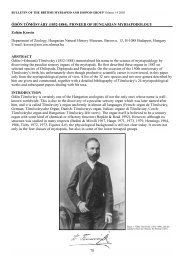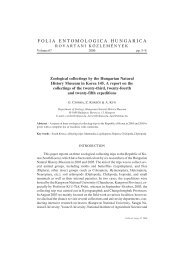History of the Herpetological Collection of the ... - Korsós Zoltán
History of the Herpetological Collection of the ... - Korsós Zoltán
History of the Herpetological Collection of the ... - Korsós Zoltán
Create successful ePaper yourself
Turn your PDF publications into a flip-book with our unique Google optimized e-Paper software.
38 Z. Korsós<br />
persons, ISTVÁN BOROS director general and OLIVÉR GYÖRGY DELY, <strong>the</strong> last classic museum<br />
herpetologist <strong>of</strong> <strong>the</strong> collection. They, with <strong>the</strong> help <strong>of</strong> international donations, <strong>of</strong><br />
many enthusiastic Hungarian zoologist collectors, and with <strong>the</strong> assistance <strong>of</strong> ERZSÉBET<br />
ÕRY, rebuilt <strong>the</strong> <strong>Herpetological</strong> <strong>Collection</strong> from nil to <strong>the</strong> size <strong>of</strong> 15,000 specimens reached<br />
by <strong>the</strong> end <strong>of</strong> DELY’s life in 2003. During DELY’s activity, <strong>the</strong> collection became a center<br />
for Hungarian herpetological research, many visiting scientists were recurring guests,<br />
two international conferences were organised in Budapest, and <strong>the</strong> scientific synopses <strong>of</strong><br />
<strong>the</strong> Hungarian herpet<strong>of</strong>auna were published. We believe that with this period <strong>the</strong> traditional,<br />
collection- and morphology-based museum herpetology came to an end, and<br />
opened <strong>the</strong> gate to <strong>the</strong> new style investigations focusing on population biology and nature<br />
conservation <strong>of</strong> amphibians and reptiles. With 48 figures.<br />
– Amphibians, reptiles, museology, Budapest, Hungary, 1956, acquisitions.<br />
THE BEGINNING<br />
The very beginning <strong>of</strong> <strong>the</strong> herpetological – i.e. collecting and studying amphibians<br />
(Amphibia) and reptiles (Reptilia) – collection <strong>of</strong> <strong>the</strong> Hungarian Natural <strong>History</strong> Museum<br />
(HNHM) cannot easily be determined. These vertebrate animals – although being not<br />
really popular among <strong>the</strong> general public – have always yielded a small, but exciting and not<br />
dismissable part <strong>of</strong> natural sciences. In <strong>the</strong> first few decades <strong>the</strong> Hungarian Natural <strong>History</strong><br />
Museum – which was established in 1802 (KORSÓS &HORVÁTH 1996, MATSKÁSI<br />
2002) – concentrated mainly on <strong>the</strong> “curiosities” (animals, plants and minerals), as many<br />
o<strong>the</strong>r similar institutes did. The first zoological items were given to <strong>the</strong> museum most<br />
probably around 1807–1808: a one-eyed pig preserved in alcohol, a dry stuffed heron, and<br />
a raven’s egg (PAPP 1992). In <strong>the</strong>se times, <strong>the</strong> work <strong>of</strong> <strong>the</strong> museum’s first “curator” (namely<br />
L T (1769–1816) who got his job in 1810) was nothing more than <strong>the</strong> organisation<br />
<strong>of</strong> donations – like <strong>the</strong> aforementioned pig, heron and egg. The first scientific zoological<br />
material – containing butterflies and beetles also – was donated to <strong>the</strong> museum in his<br />
time, in 1811, in <strong>the</strong> form <strong>of</strong> <strong>the</strong> collection <strong>of</strong> a lady, ANNA JORDÁN from Nagyszombat<br />
(through <strong>the</strong> purchase by FERENC STIPSICS, Canon <strong>of</strong> Esztergom, see FRIVALDSZKY 1880,<br />
HORVÁTH 1902). We do not know anything more about her. TEHEL had two volunteer assistants,<br />
one <strong>of</strong> whom was PÁL JÁNOS JÁNY, who later became a regular employee and <strong>the</strong><br />
keeper <strong>of</strong> <strong>the</strong> zoological collection. TEHEL – who was considered a mineralogist by his contemporaries<br />
– established <strong>the</strong> first exhibition <strong>of</strong> <strong>the</strong> museum in 1810, and later, in 1815, he<br />
compiled <strong>the</strong> plan for ano<strong>the</strong>r one, which he was unable to accomplish, because he died at<br />
<strong>the</strong> early age <strong>of</strong> 47 in 1816 (PAPP 1992).<br />
(?–1834), <strong>the</strong> first “Curator Camerae Zoologicae” – keeper <strong>of</strong> <strong>the</strong><br />
zoological collections – was an employee <strong>of</strong> <strong>the</strong> museum between 1814 and 1822. In <strong>the</strong>ir<br />
(TEHEL’s and JÁNY’s) time, in 1815 <strong>the</strong> items <strong>of</strong> <strong>the</strong> National Museum were organised in a<br />
determined order (ANONYMOUS 1815):<br />
Annls hist.-nat. Mus. natn. hung. 100, 2008




